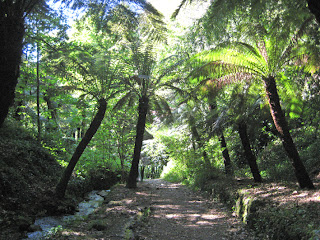National
Forest of Bussaco is a 105 hectare forest which contains more than 700 species
of trees, a Palace (now a five star hotel) and a Carmelite convent. After paying the 7€ entrance fee we confirmed
it was OK to stay the night and continued up the hill bypassing the car-park,
as there were heavy tree felling operations going, on and parking by the trees
next to the 5*Hotel. A much better view
thanks.
There was
a hermitage here in the 6th century inhabited by Benedictine monks
but in 1628 the Carmelite order extended.
They built a convent and introduced exotic species of trees and shrubs,
laying cobbled paths and enclosing the forest within walls. There is evidence that during the Peninsular
War the future Duke of Wellington stayed at the convent the night of his
victorious battle in 1810 (not sure which room he was given as they are all
about 6 foot square!)
 |
| The Convent |

In 1834
when religious orders were abolished in Portugal, the forest became state
property. The Palace was built in 1907
as a royal summer residence but then the monarchy was abolished three years
later so the royals hardly got a look in.
All to our benefit.
 |
| The Palace Hotel |
Having
spent the day there we followed most of the various paths which lead to ponds, waterfalls
and chapels together with one area containing a collection of tree ferns from
new Zealand. One really steep path,
which leads eventually to the highest point at 545 metres, contains depictions
of the ‘stations of the cross’ inside dark square stone structures. We only saw three of them (path too steep)
but where amazed by the detail of the terracotta figures within.
Sadly,
there was a very bad storm on 16th January this year and evidence of the
devastation is everywhere. 400 year old trees with their tops torn off,
others that have crashed through a hermitage building and the visitors’ centre
and lots of paths are now a bit tricky to negotiate.
Lots of
hard work is being done to clear all this up …….. hence the closure of the car-park!!


























